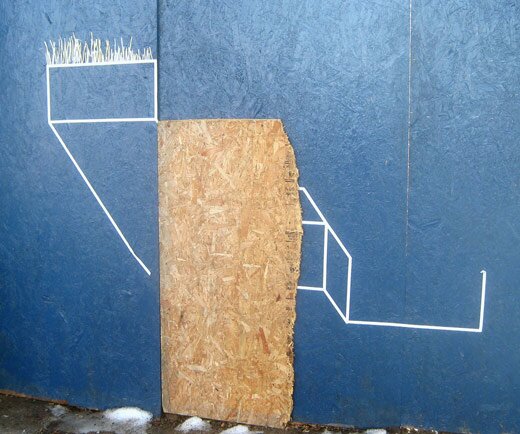intellectual property
Archived Posts from this Category
Archived Posts from this Category
Posted by ben on 24 Mar 2009 | Tagged as: architecture, design, intellectual property, public art
UPDATE: I just talked to Bill FitzGibbons about an error and some clarifications that need to be made in this post. First off, FitzGibbons is being sued by the City of McAllen. FitzGibbons’ lawyers had drafted a letter to the city to discuss the apparent infringement of his rights, and the city responded by suing in federal court, requesting a ruling affirming their legal right to install this piece.
Apart from that glaring error, FitzGibbons pointed out compositional and conceptual similarities between the pieces. I have only seen two photos of the underpass in McAllen, so I’m just passing on FitzGibbons’ description. Compositionally, the McAllen piece is apparently very similar to Light Channels, in terms of the colors it uses and their sequencing. (In the Current article, McAllen officials are quoted as saying it is different because they did not employ the “chasing” effect that can be seen in Light Channels). Conceptually, Light Channels was designed to connect downtown San Antonio to the near east side, which is cut off by a highway. Highways create psychological barriers, the underpasses mostly being associated with vagrants, but Light Channels turns this into a safe, welcoming passageway. Similarly, , dividing downtown from the mall, the country club, the airport, and, just a little further south, from the border with Mexico. The underpass lighting in McAllen is at the intersection of 83 and S 10th St, a major street that leads the attractions listed above. FitzGibbons’ argument, then, is that conceptually as well as formally, this work mimicks Light Channels. Architectural lighting has been used on underpasses in a number cities; it is the form and purpose of the lighting that this case is dealing with, not the use of lights.
The original post is below:
The Current did some research into Bill FitzGibbons’ lawsuit against the city of McAllen, Texas for apparently ripping off his “Light Channels” piece in downtown San Antonio. From what I can tell, it’s pretty clear that McAllen’s new installation is at the very least extremely derivative of FitzGibbon’s work, and the city officials really ought to be ashamed for so blatantly ripping him off.
But at the same time, I’m not so sure about how successful this lawsuit will be. The lighting system FitzGibbons uses was developed by Philips, and is used for architectural lighting all over the world. If FitzGibbons can sue McAllen for sticking the lights in a highway underpass, whats to stop Fisher Marantz Stone (designers of the lighting on Brooklyn Borough Hall) from suing FitzGibbons himself for a similar use of Color Kinetics on the Alamo? This highlights the differences between designers’ and artists’ attitudes towards intellectual property. While a designer may regard a cheap imitation of her work with contempt, she’s generally not going to sue the offending party unless it’s an exact replica. Artists, I think, tend to feel a stronger sense of ownership over their work and even their concepts.
This may prove to be an interesting legal battle, as it seems it will be fought in something of a legal gray area. Of course, I’m not a copyright lawyer, and the case could be a lot more clear cut than I assume.
Posted by ben on 02 Feb 2009 | Tagged as: art paparazzi, graffiti, intellectual property, public art
Barry Hoggard posted a photo of a modified Aakash Nihalani piece in Williamsburg to his Flickr account yesterday:

When I saw this, I realized that street art is the original Creative Commons. Put something in a public space and it just begs for “collaboration,” resisting any claim to copyright. (Yes, I know that Creative Commons is not intended to do away with copyright but to make it more flexible, and that street art is more like a perpetual public domain).
Posted by ben on 16 Jan 2009 | Tagged as: intellectual property, politics, video/film
Nate Anderson at Ars Technica covers what is probably the best cause célèbre I’ve seen for oponents of restrictive copyright enforcement. The article recounts the case of Kevin Lee, a prolific film blogger who used YouTube extensively to publish “video essays” which interspersed his own critical insights with short film clips. Lee’s work demonstrates everything that’s good and noble about the Internet: an unpaid blogger pioneering new avenues of critical discourse, just to share his love of cinema with others. His blog, Shooting Down Pictures, reveals a passionate, intelligent observer documenting his travels through the greatest 1,000 films. Read more about the significance of Lee’s work at The House Next Door.
But all this came to a grinding halt when, after a third DMCA takedown notice was served against Lee, over five hours of his critical commentary was deleted by YouTube and his account closed. I’ve written about what I see as some helpful innovations on YouTube’s part in dealing with copyright, but this “three strikes” rule is absurd on its face. YouTube offers some fair objections to the idea that it should manually review all of these takedown notices, but deleting whole user accounts due to a small ammount of allegedly infringing content is bad for YouTube, bad for free speech, and will ultimately feed the backlash against copyright in general. It’s not even clear that the video that triggered the account deletion was violating copyright; Lee has a strong case that his critical videos fall under fair use protections.
The blame for this doesn’t fall entirely on YouTube, as many of the large rights holders are taking a “shoot first, ask questions later” stance with takedown notices, and of course the DMCA itself encourages this behavior. Any lasting solution will involve a combination of legal reform and consumers creating a shitstorm whenever something like this happens.
[Cross-posted at Scattered Work]